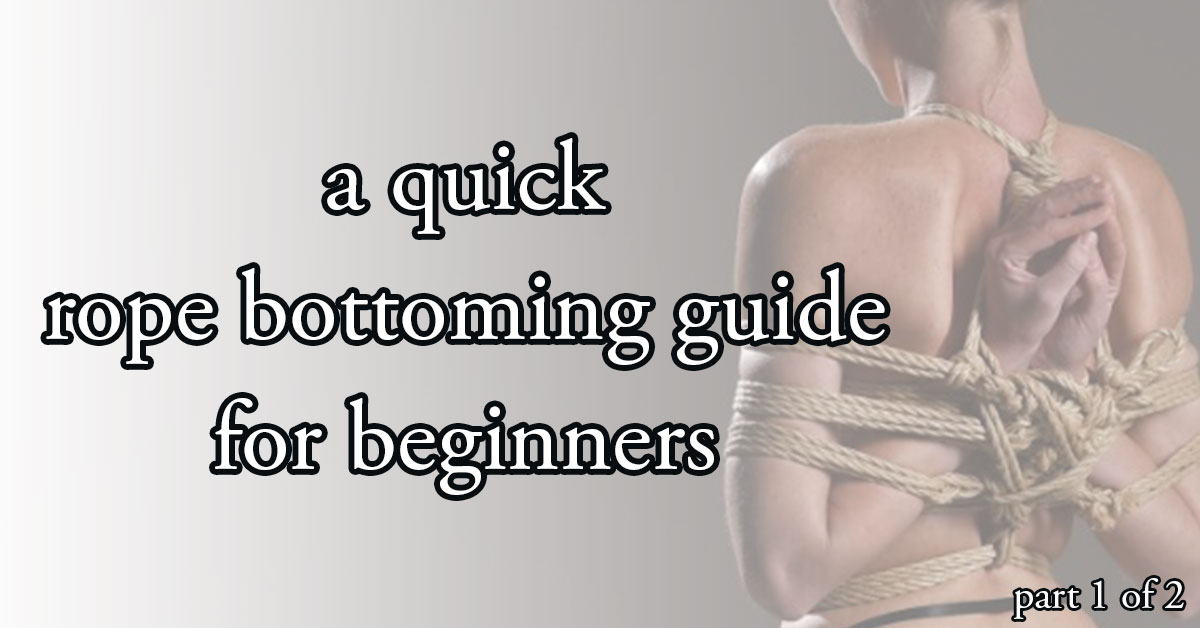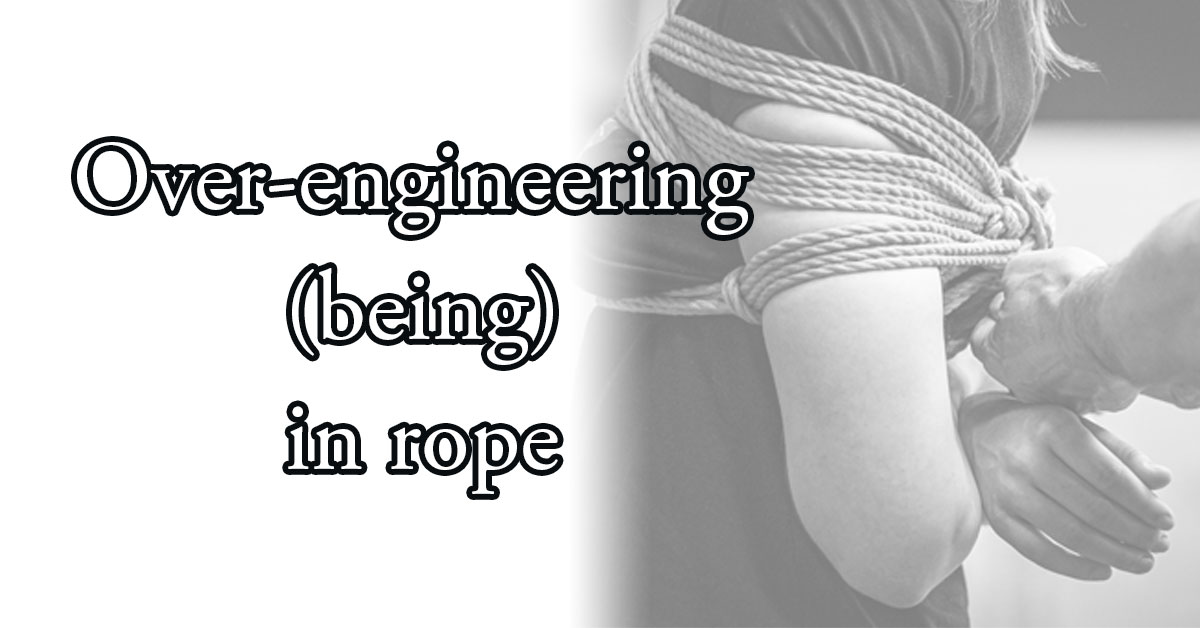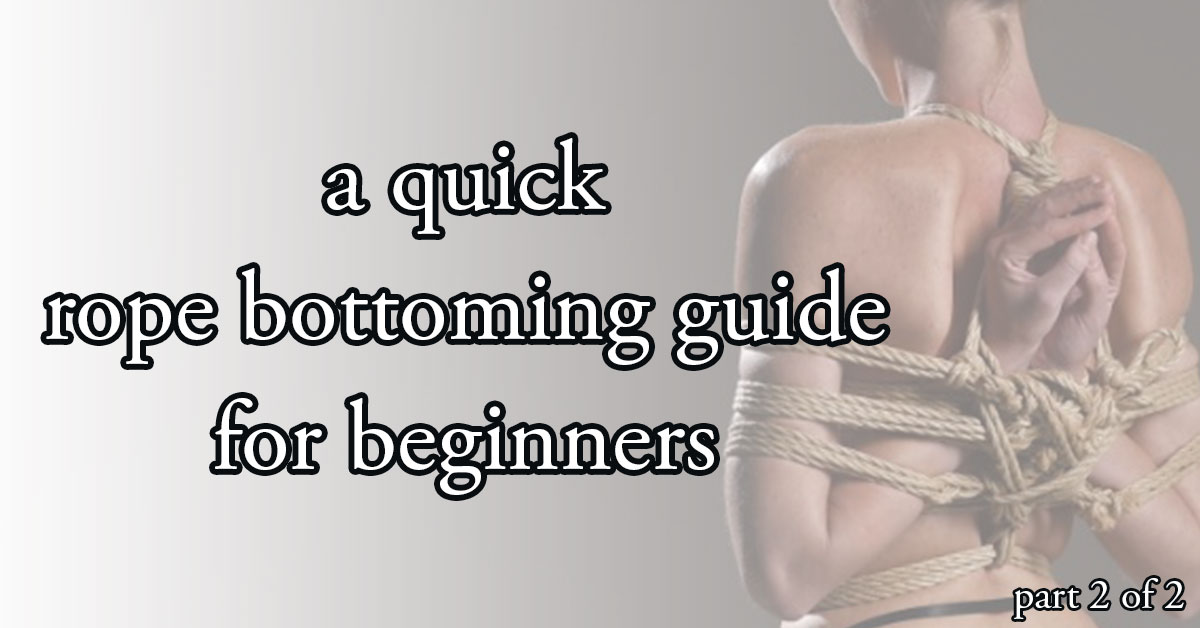What should beginning (or aspiring) rope bottoms know? This quick guide aims to present some answers to that question. It’s based on my personal experience of when I just started getting tied, and on the things I wish I knew looking back now. No (wo)man is an island, so my view isn’t formed in a vacuum: it’s based on conversations I had with other rope bottoms and riggers, on co-teaching rope workshops (as a model) for beginning and more advanced rope students and on my observations at rope jams, performances and workshops. I am not claiming that I know it all, nor that this guide is complete. I do believe it can provide a good starting point for beginning or aspiring rope bottoms.
This guide is mostly written for rope bottoms entering the rope scene, and not for rope bottoms who are tying with a partner they knew beforehand, even though they might take something helpful from this guide as well. In part 1, I will mention some points to take into account when making your way into rope. In part 2, I will mention some thoughts for the moment that you are in rope, both from a mental and practical perspective. Feel free to take whatever you liked from this guide, and ignore what you did not like. In the end, what you want to get out of rope is highly personal, and nobody can tell you what you should like, or how you should do it.
Over-communicate
In Dutch management terminology, there is a commonly used abbreviation ANNA: Altijd Nagaan, Nooit Aannemen. It (kind of) works in English as well: Always Ask, Never Assume. This seems like an open door, but in my experience, asking and not assuming does not happen enough in rope communication. Quickly assuming without checking is all too human, but that does not make it right or smart. It can lead to miscommunication, mismatched expectations and therefore unpleasant (or worse) experiences in rope. So when in doubt, always – please – just ask! Ask your questions at workshops, rope jams or munches that you are attending. And just as much ask the person you might be tying with. You can never be too clear about things. And most of all, don’t worry about asking a dumb question. The fact that you are even asking questions is a sign that you want to be well informed and are assertive, smart and brave about your start in rope. If somebody makes you feel as if you are asking a dumb question, it’s not the kind of person you need in your ‘rope circle.’
Talking to other rope bottoms
One of the best ways to get more knowledge on what you want in rope, what to expect and what to look out for is to share your questions and ask for the advice of other (more experienced) rope bottoms. Even though all rope bottoms are unique and have their own personalities and wishes in rope, talking to them can be helpful. You can talk to rope bottoms at rope jams, munches and on FetLife, where some of them are open to talk in DMs. If that’s the case, rope bottoms usually put that on their FetLife profile, but you could also send somebody a message and ask politely. Listen to their stories, and see what resonates with you and what does not. Just because one person likes or dislikes a tying style or a rigger does not mean that it will be the same for you. So, use their experiences as a context to guide your own thinking and decision making.
New Rope Bottom Energy (NRBE)
You can go through something similar to New Relationship Energy (NRE) – as it is described in polyamorous circles – when you are a new rope bottom. Let’s call it New Rope Bottom Energy (NRBE). It’s a similar feeling to the early stages of being in love, where you feel super excited about your newfound passion (or person). When it comes to rope, it can make you want to try everything, with all of the people, as quickly as possible. The rope/kink scene can seem like a candy store, where you can finally taste the forbidden fruits that were hidden from you for so long. This passionate and vibrant energy is awesome and is there to be enjoyed! However, being aware that NRBE exists and that you might be influenced by it is helpful. NRBE can cloud your intuition and influence your decision and risk taking. My suggestion (but this is quite personal, so you might disagree) is to think of your rope bottom adventure as a marathon and not as a sprint. Give yourself some time, don’t feel rushed into trying things quickly, and be okay with taking things slow, especially if you are not sure of something/someone.
Don’t take rejection personally
Ask 100 riggers why and how they tie, and you will likely get 100 different answers. There are different intentions for tying or getting tied: some people see rope as BDSM, some as sexual, some as artistic, some as spiritual, some as romantic, some as dance, some as play, some as hardcore torture… the list is endless. Some riggers have multiple tying partners and enjoy tying with beginning bottoms. Other riggers only tie with their established partner(s). Just like you have all the right to say no to tying with a rigger, a rigger has just as much right to not want to tie with you. They only owe you common human decency when telling you no. It doesn’t mean that you are unattractive or unsuitable as a rope bunny. There could be a variety of reasons why somebody does not have the time or interest to tie with you. And never, ever try to change yourself, your boundaries and your wishes in rope to match with a rigger.
Ask yourself: ‘why?’
The same goes for rope bottoms: ask 100 of them why and how they like to be tied, and you will likely get 100 different answers. So, it’s a good idea to redirect this question to yourself: what is it that attracts you about rope? Are you looking for power exchange and a long-term D/s dynamic with one person that includes rope? Are you looking for playful and casual exchanges with multiple people? Would you prefer rope modeling, for instance mainly tying to take pictures for Fetlife or Instagram or would you like to mainly tie in private without any pictures taken? Do you think rope is sexual to you (and what does sexual mean)? Of course, your views will change over time, and you cannot have definitive answers before you start. Having a general idea on what you are looking for is however helpful to understand which communities or people might be a good fit for you, and which ones won’t be.
Vetting
How do you know whether a rigger ties safely? Sadly, it’s a question that cannot really be answered, for the main reason that rope is never ‘safe’. Rope bondage – no matter what style – is a form of edgeplay in BDSM, meaning that significant physical (and some would say emotional) risks are involved. What you can do, however, is ask multiple other rope bottoms who have tied with a rigger about their experiences with them. This process is called vetting. It’s far from a foolproof method, but if you are unable to find any bottom who can vouch for a rigger, it can (but does not have to be) a warning sign that something might not be right. Yet, it is unfortunately also the case that many people vet riggers who would – in my books – not be safe to tie with. It’s therefore a tricky topic, but vetting can be a part of a method to keep yourself more safe.
Expectation management
Rope bottoming is a skill in itself that you can develop over time. Other (more experienced) bottoms can make being in rope look easy, but that does not mean it is easy for them, or that it was easy for them from the start. So don’t beat yourself up over not being able to sustain all ties right away, or for not really knowing how rope ‘should’ feel and knowing whether you are doing things ‘right’. The main way you can get to know yourself in rope is by gaining bottoming experience over time. Everybody has to start somewhere, and challenging times in rope or failed ties are generally not shared on the internet or in a public place. So, be okay with being a beginner! And even all non-beginning rope bottoms have their own ‘weaknesses’: ties they cannot sustain, body parts with heightened sensitivities or past injuries, difficulties with communicating when in rope, etc. It’s an ongoing learning process with highs and lows for everyone.
Social media
Don’t think that what you see on social media (mainly Instagram and Fetlife) corresponds with the truth in rope. You generally only see a picture of the final position and you don’t really know anything else. You don’t know the level of experience of the bottom and rigger, you don’t know how often they have tied together, you don’t know how often they have failed at achieving a similar position, and you don’t know whether the bottom came out of the position with nerve damage, dizziness, nausea or any other kind of unwanted or harmful physical reaction. You furthermore also don’t know about the overall experience of the bottom: they might have been struggling throughout the whole scene because they wanted to ‘achieve’ a certain picture to post on social media, and the rigger might have been pushing beyond their bottoms’ as well as their own limits as well. So, even though it can be nice to be in awe and inspired by what others are doing, it’s a good idea to take these pictures with a (big) grain of salt.
Keep a RopeLog
Something I wish I had done when I started getting tied (but did not do) is keeping a RopeLog. You could see it as a mini-diary where you write down short notes of reflection on the rope sessions that you have had. What went well? What did not? What was very enjoyable, and what was something that you would do differently next time? What is something that you want to continue exploring, and what was less pleasant? Do you wish you had communicated more or differently with your rigger? Do you wish your rigger would have done something differently? Continuous self-reflection (for instance by means of a RopeLog) is a way to get more insight into yourself as a rope bottom, and to better understand what gets you going and what does not, especially in the beginning of your rope bottom adventures. Sharing (some parts of) it with the rigger can also be a good idea. I think it’s a shame that I did not keep one at the start, because I would have loved to read it back now, to see how much I have changed!
Where to start?
Now down to a more practical point: how and where to start exploring your curiosity for rope, when you do not have a partner/partners for it yet? The FetLife page RopeEventsNL keeps an overview of all rope related events in the Netherlands. If you are scared of going to a rope jam or much by yourself, you can always message one of the organizers. They might be so kind as to match you with a ‘buddy’ at the event or to introduce you to some people. Another thing you could do is send a message to a rigger stating that you are curious about getting tied up and ask them if they might have interest in tying with you.
I would strongly and seriously advise you to NEVER meet up with them in private if you haven’t met them before. It’s a better plan to meet up for a coffee in a public place and to bring a friend along with you. Writing a message to a rigger is more risky and can be less successful because 1) you do not know anything about this person on a personal level (not as a rigger) and whether they are an overall decent human being and 2) the rigger can end up feeling like a fetish dispenser, meaning that they can feel used by you as a rope ATM that has to provide you with a nice experience, when you are merely using them for their skillset. This is of course not the case for all riggers. But if you send someone a message, it’s a good idea to make it personal, to stay polite and be clear about your intentions and what you might be looking for. Only writing “plzzz tie me up cause I need it so bad” will probably not go well. And if a rigger would engage with this kind of inquiry seriously, I believe it also shows something (negative) about the rigger’s intentions.
When you are thinking of approaching a rigger, it’s also good to question yourself on what you think this rigger might be looking for. What would they get out of tying with you? Are they a beginning rigger who hopes to build a rope relationship with someone to learn together? Do they hope that more can come out of tying (ex: dating, sex, other benefits)? Are they tying semi-professionally and do they hope you will model for them at workshops, photoshoots or shows, and is that something you would want? Being clear about this – or at least thinking and talking about it – with the rigger (and yourself) from the beginning on is a good idea.
In the case that you have found a partner with whom you feel good, and with whom you want to experience rope: great! Checking the RopeEventsNL for workshops and rope jams that are being organized is a good place to start. Most riggers and models also offer private workshops in case you don’t feel comfortable with taking one in a group.
Potential red flags in riggers
These are some warning signs that can show that a rigger might not have the best practices or intentions in mind. This is not an exhaustive list, but I would say that some examples are when a rigger:
– Tries to pressure you out of limits that you have set for yourself;
– Doesn’t discuss safewords and limits in the first place;
– Doesn’t talk with you about the main risks of rope bondage and how to recognize warning signs for nerve damage (especially when they know that you are a beginner);
– Doesn’t ask you about any physical past injuries or weaknesses that you have;
– Is vague about or not okay with being vetted;
– Is not okay with you bringing a friend or with tying in public (at a rope jam) for the first time tying together;
– Compares you to other rope bottoms to make you feel bad (ex: rope bottom Y can handle this position much longer/can handle more intensity than you);
– Implies but is not clear about the fact that sex/nudity is always a part of a rope session with them;
– Pressures you into wearing or not wearing certain clothes. The only thing that a rigger should tell you not to wear as a bottom with boobies is a wired bra, because the wire can cause unwanted pressure on sensitive nerves. A wireless bra or sports bra is totally fine. Jewellery can also be inconvenient because rope can get stuck behind it, just like behind baggy clothes. Besides that, you are free and safe to wear whatever you like. Some people like to wear tight-fitting yoga clothes, some like dresses, some like underwear and some people prefer to be naked.
Supposed green flags in riggers that actually don’t mean a lot
– An extensive collection of impressive rope pictures on their profile;
– An extensive amount of followers on their Fetlife or Instagram profiles;
– An extensive amount of impressive people they have tied with on their profile;
– An extensive list of workshops they have attended on their profile;
– Teaching their own workshops;
– Having their own website;
– Hosting a rope jam/rope event.
I hope this was helpful! Stay tuned for part 2. The second part focuses on being in rope: what are safety concerns and points of communication you should be aware of before, during and after getting tied? I would love to hear additions from other rope bottoms or riggers in the comments, so I can include some of the ones I have missed in this article!
Part 1 | Part 2 | the Shady Lady | RopeMarks Ryu | RopeMarks












Leave A Comment